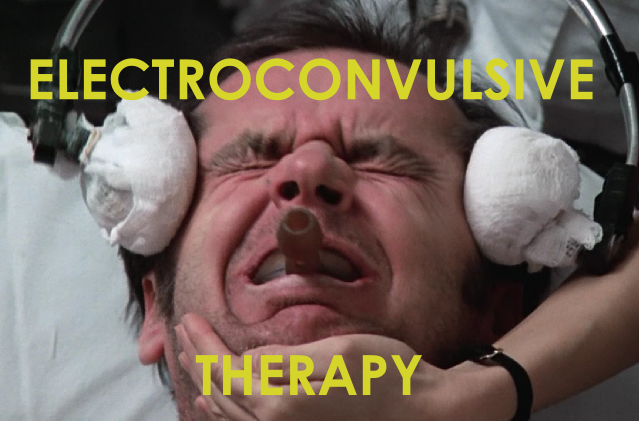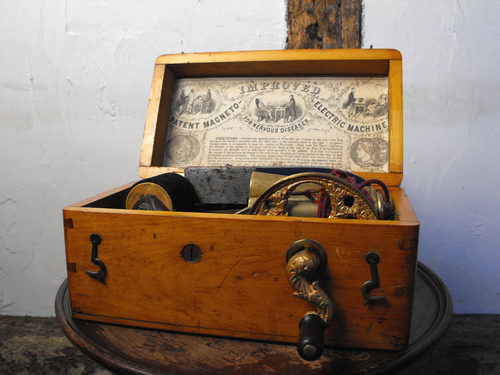Electroconvulsive Therapy (ECT), commonly known as Electroshock Therapy, has certainly gotten a bad rap. When most people imagine this treatment, they conjure up images of some sadistic psychiatrist laughing as he tortures his helpless patients. There are many misconceived notions about ECT, so I thought I would let you all know a bit about its history and why, in reality, it’s a good thing (despite the harrowing photo above).
The Origin of Electroconvulsive Therapy
ECT dates back pretty much to the dawn of recorded history. Before we found biological reasons for mental illness, humans believed that patients who suffered from schizophrenia and other illnesses were possessed by evil spirits. Hippocrates and his colleagues even spent time searching for plants that could induce seizures in hopes of “shaking the evil spirits from the body.” Doctors attempted many different methods to induce seizures such as fever, insulin, and camphor, before finally settling on electricity.
Vintage Electroconvulsive Device
In the 1930’s, Italian scientists, Ugo Cerletti and Lucio Bini noticed that if their patients who suffered from epilepsy had a series of seizures, then subsequently, their depression would be temporarily cured. After testing electric shock on pigs, they moved on to human subjects with excellent results. ECT gained tremendous popularity throughout the 1940’s and 1950’s before suffering from negative publicity.
So why so much negativity? Throughout the 60’s and 70’s, ECT was certainly overused. We didn’t have all of the pharmacological treatments that we do today, so we depended entirely too much on ECT as a treatment for all types of mental illness. Many physicians were accused of using ECT as punishment for poor behavior. Furthermore, physicians didn’t really use the muscle relaxants that we have today. During the seizures, patients would convulse their bodies violently, often resulting in bodily harm, especially in the older patients.
Back to the Basics
So What Exactly is ECT? A psychiatric treatment in which a generalized central nervous system seizure is induced by means of electric current.
Indications: It works for ALL types of Major Depressive Disorder. It is also used for psychotic depression, depression refractory to pharmacotherapy (for some patients who are acutely suicidal), mania, and bipolar disorder.
Administration: Treatments are usually given 3x a week — on Mondays, Wednesdays, and Fridays for about a month. Electroconvulsive shock is applied to one or both cerebral hemispheres to induce a seizure. Variables include stimulus pattern, amplitude, and duration. The goal is to produce a therapeutic generalized seizure 30–60 s in duration. Electrical stimuli are usually administered until a therapeutic seizure is induced. A good therapeutic effect is generally not achieved until a total of 400–700 seizure seconds have been induced.
Anesthesia: General anesthesia – usually Propofol (+ Lidocaine for the burn of the injection). And a Neuromuscular blocking agent – succinylcholine, which helps relax all of the muscles from convulsion for safety.
Does it Really Work? Yes! Not only does it work, but it is actually the MOST EFFECTIVE treatment of severe depression with an efficacy of ~ 70-85%. Comparative controlled studies of ECT and pharmacotherapy show that it is more effective. This means that it works more often then Prozac, Zoloft etc… This is only a short term treatment, however, and maintenance treatments must be used to continue the beneficial effects.
Contraindications: There are no absolute contraindications to the use of ECT. It can even be used in pregnancy! – 2 reviews found a risk of about 5-10% for complications in pregnancy => should only be used when depression is recalcitrant to intensive pharmacotherapy.
Side Effects: The most common are memory disturbance and headache. Unilateral ECT is associated with less memory loss. Most memory faculties return to full capacity within several weeks. Confusion often lasting from minutes to hours is common, but reversible.
Other Options for Treatment: Vagus Nerve Stimulation, Transcranial Magnetic Stimulation, Psychotherapy, Pharmacotherapy. But none of those are as efficacious as ECT!
And if you would like to see a great TED talk on ECT, watch below, it’s quite moving:
Surgeon and author Sherwin Nuland discusses the development of electroshock therapy as a cure for severe, life-threatening depression — including his own. It’s a moving and heartfelt talk about relief, redemption and second chances.
Well, hopefully you enjoyed this information a bit. Electroshock for the win.
-RSB
References:
CURRENT Diagnosis & Treatment: Psychiatry > Section II. Psychiatric Disorders in Adults >
Chapter 18. Mood Disorders. Peter T. Loosen, MD, PhD, Richard C. Shelton, MD
Behavioral Medicine: A Guide for Clinical Practice > Section IV. Mental & Behavioral Disorders >
Chapter 22. Depression. Steven A. Cole, MD, John F. Christensen, PhD, Mary Raju Cole, RN, MS, APRN, BC, Henry Cohen, MS, Pharm D, FCCM, & Mitchell D. Feldman, MD, MPhil
Clinical Anesthesiology > Section IV. Physiology, Pathophysiology, & Anesthetic Management >Chapter 27. Anesthesia for Patients with Neurologic & Psychiatric Diseases. Steven A. Cole, MD, John F. Christensen, PhD, Mary Raju Cole, RN, MS, APRN, BC, Henry Cohen, MS, Pharm D, FCCM, & Mitchell D. Feldman, MD, MPhil


